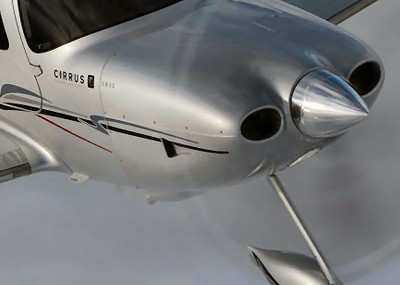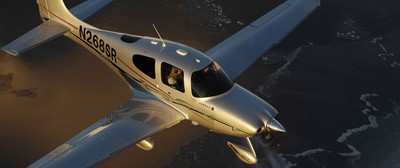Another Step In A Very Evolutionary Program
Flight Test Report and Analysis by ANN Editor-In-Chief Jim
Campbell
 Part of the true
difficulty I'm having these days in publishing a flight test
analysis is distinguishing those properties and capabilities that
are (in large part) hard to quantify without a great deal of
subjectivity. It's not enough to conclude that an aircraft exhibits
a good or bad characteristic... it has to be distinguished in terms
of mission requirements, pilot experience, real-world needs, and
(finally) compared to other aircraft competing for a pilot's
attention in this overly talented GA market.
Part of the true
difficulty I'm having these days in publishing a flight test
analysis is distinguishing those properties and capabilities that
are (in large part) hard to quantify without a great deal of
subjectivity. It's not enough to conclude that an aircraft exhibits
a good or bad characteristic... it has to be distinguished in terms
of mission requirements, pilot experience, real-world needs, and
(finally) compared to other aircraft competing for a pilot's
attention in this overly talented GA market.
This is not like the good days... in which there were a number
of good and not-so-good characteristics to describe the popular
aircraft of the time... no, in this day and age, the aircraft
offered to the flying public are such a cut above what we saw a few
years ago, that had one had a time machine able to look forward,
one could not be trusted to believe what was coming. Today's GA
birds are that GOOD... and consistently so.
So... in evaluating the newest breed of Cirrus against its
competition (and itself), we can't help but be impressed and
thankful that the industry has progressed this far. Not only that,
it has done well in an ever-evolving market that is
finally giving the GA pilot unheard-of capabilities and performance
-- in terms of what they used to have to settle for. These are good
times for GA aircraft buyers.
So... in evaluating the Cirrus G3, we've decided to offer a
direct comparison in order to get to the bottom of what this
aircraft represents -- and we've decided to compare it to the
toughest competition it may face... the Cirrus G2 series.
From the terrestrial standpoint, there is little to distinguish
the G3 from its forebears, in terms of overall differences. I did
appreciate the fact that the tiedown points have moved toward the
tips a bit more, making it easier to access them and that much
easier for the average tie-down ropes to reach them, to boot. All
normal cockpit chores share similarities with those used in the
past, though the constant evolution in cockpit decor and layout
continues to be appreciated and impressive to those who get to
travel inside. Despite the taller, narrower gear, there is no
downside to the new gear geometry. While the turning radius,
physically, is a mite tighter than the old one, the free-castering
nose allowed for aggressively tight turns to start with and
excellent ramp maneuverability -- so no major issues there. The
slightly higher stance seems to ride just a tad more solidly when
dealing with less than even surfaces, and the additional prop
clearance has to be a reassurance when dealing with some of this
country's declining airport infrastructure.

Lining up on the active runway at Duluth, I deliberately ignored
the numbers for a bit in order to simply feel out the aircraft's
inherent abilities. While the G3 offers excellent pitch authority
early in the takeoff roll (about the time the airspeed gets active,
the tail makes itself known), there is little question that a
little more pitch persuasion is required for the slightly more
nose-heavy G3.... especially the Turbo. It's not obnoxious or
difficult, just a tad more demanding in that department, to the
tune of a few more pounds of aft pitch pressures to achieve the
desired results at liftoff and in initial climb.
Performance in the takeoff profile remains outstanding... with
the G3 proving that it can meet or exceed the POH 's promises. With
two aboard, over 70 degrees on the deck and nearly full fuel, the
G3 had no problem exceeding the published 1400 fpm climb rate by
several hundred feet through the first few thousand feet of our
climb profile when I kept to best climb numbers.

Initial control investigations revealed that this bird has
definitely been the recipient of some TLC... while the Cirri that
preceded the G3 were no slouches on the stability and control
department, the enhanced dihedral of the wing and the lack of the
mechanical interconnect has freed up roll control in some
delightful ways. The affect is slightly less demanding, somewhat
more responsive, and presents an even more balanced feel than its
forebears. In other words... it's just more fun to fly. I truly
enjoyed the enhanced rolling authority and the balanced feel
presented by an even more effortless coordinated turn. I'm not
knocking the old system, I'm simply expressing a preference for
this one... it's a little bit more lively and when dove-tailed with
the new wing (especially the enhanced dihedral effect), the overall
profile is both agile, as well as quite stable.
Pitch presents itself as slightly heavier in overall
tone as well as slightly nose-heavier throughout the
envelope... particularly at approach speeds. The G3 version of the
SR22, like those before it, boasts an excellent stability profile
for a cross-country airplane. Pitch is typified by a very well
defined static profile with an attendant dynamic pattern that damps
out quickly after 10 and 20 degree, stick-free, displacements from
cruise configuration. Short period excitations produce nearly
deadbeat corrections and the G3 seems even a little more obedient
than previous generations. In other words, pitch stability (once
again, like before) seems much like riding a rail. Approach modes
are nearly as well-behaved, are slightly better defined than
previous generations (especially in terms of dynamic behavior), and
demonstrate excellent speed stability throughout normal approach
ranges.

Overall control pressures (like before) vary from somewhat light
to the high side of moderate, but never quite 'heavy' until you
have to wrestle it around at the limits of the control
envelope--then it gets a bit laborious. Lateral stability is very
well-defined (and boy, can you pick up a wingtip with a rudder, now
-- even more acutely than before), spiral properties are
surprisingly mild-mannered, and the dutch roll properties damp out
even quicker than before. As a result, this bird rides "the bumps"
quite solidly and with little attitude displacement throughout a
wide range of sloppy air. Roll pressures are slightly lighter and
continue to lighten up perceptibly (but in proper proportion) in
slow flight mode. The now unencumbered rudder continues to meld
well with this airframe…especially when it slows
down… small (and very lightly pressured) boots of rudder
produce excellent and agile response in approach ranges that will
be just about perfect for modest corrections in holding to a
localizer.

The lack of mechanical coupling doesn't create a whole lot of
changes in overall handling, but the feel is lighter, somewhat more
agile and even more obedient, due to the fact that yaw/roll is now
a mix fully designated by the P.I.C. Like before, when flying in
the 80/85-110/115 kt range (just a mite faster than the older birds
due to the new pitch profile)… it makes easy work of wind
corrections and the occasional brain fades that occur when fixating
on the glideslope instead of the localizer. I must note that the
Turbo birds, with a slightly more nose-heavy propensity, will be a
bit more easily maneuvered if the pilots tack on about 5 knots, and
a little more power, to all their former bug speeds... this gives
the elevator a little more oomph in the low range and decreases aft
stick pressures just enough to ease the chore of approaching at low
speed.
To Be Continued...
 ANN's Daily Aero-Linx (04.15.24)
ANN's Daily Aero-Linx (04.15.24) Classic Aero-TV: 'No Other Options' -- The Israeli Air Force's Danny Shapira
Classic Aero-TV: 'No Other Options' -- The Israeli Air Force's Danny Shapira Aero-News: Quote of the Day (04.15.24)
Aero-News: Quote of the Day (04.15.24) Airborne 04.16.24: RV Update, Affordable Flying Expo, Diamond Lil
Airborne 04.16.24: RV Update, Affordable Flying Expo, Diamond Lil ANN's Daily Aero-Term (04.16.24): Chart Supplement US
ANN's Daily Aero-Term (04.16.24): Chart Supplement US







